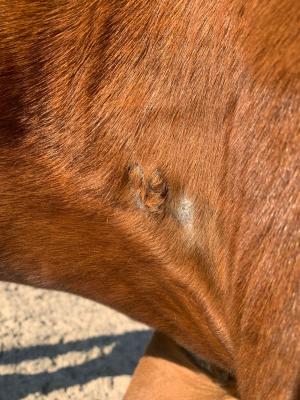
By vet Bethan Harper
Sarcoids are a common type of skin cancer that affect up to 8% of the equine population with no known age, breed, or sex predilection. More research is required to fully understand the cause of these tumours but there is a known link with Bovine papillomavirus (BPV) which can cause sarcoids in genetically susceptible individuals.
The transmission of sarcoids from one horse to another via direct contact or biting flies has been widely theorised although so far there is no evidence to prove this. However, evidence does suggest that susceptible horses grazing with sarcoid affected horses are more likely to develop sarcoids.

Sarcoids can be locally aggressive, but do not metastasise throughout the body, and are only found on the skin. They may remain stable for a long period of time but then suddenly grow or ulcerate, and any disturbance or trauma may exacerbate aggressive growth. Additionally, as the sarcoid grows and the roots become more extensive it becomes more difficult to remove them.
There are four main types of sarcoid; occult, verrucous, nodular, and fibroblastic, which vary in appearance and behaviour. These are often distinguished by their look alone, as biopsy may aggravate the sarcoid and encourage growth. Horses may have multiple types of sarcoid at one time, or even different types at one site (mixed sarcoid).
Occult sarcoids are frequently found on the groin or head and appear as a thickened, hairless area of skin with a rough surface. They are usually slow growing and can easily be mistaken for rub marks or ringworm.
Verrucous sarcoids are frequently found on the head, axilla or inner thighs. They have a scaly, warty appearance. In early stages they might have an area of hair thinning or loss surrounding them. They are usually slow growing and may be confused with ringworm, scar tissue, or skin overgrowth following trauma.
Nodular sarcoids are often located in the axillary region, inner thigh, groin or on the eyelid.
These appear as well demarcated lumps which may be mobile under the skin or more firmly attached to the overlying skin. Nodular sarcoids may change in appearance over time, becoming ulcerated and bleeding.
Fibroblastic sarcoids have a fleshy appearance and often occur in clusters. Fibroblastic sarcoids can be subdivided depending on the presence or absence of a small pedicle (stalk) attaching the sarcoid to the body. These sarcoids can commonly be found at all sites but have the highest prevalence over limbs and joints, particularly where there has been a wound. They are more aggressive than the other types and as such they grow rapidly and can invade the tissues beneath the skin. Early treatment is therefore essential to avoid the formation of an unmanageable ulcerated mass.
Due to the variation between the different types of sarcoid there is no singular optimal treatment. The type, location and extent of the sarcoid will all be factored into the choice of treatment as well as the horse’s temperament and any financial considerations. Regardless of the type of treatment used, starting early when the sarcoid is small will give the best chance for successful resolution.
The most common medical treatments include topical chemotherapy cream, immune modulating creams, and vaccines or chemotherapy drugs that can be injected into the tumour. The other option for sarcoids is surgical removal which may be achieved with ‘smart’ surgery, cryotherapy (freezing), or laser surgery. Ligation (banding) of sarcoids used to be a common treatment but this can be dangerous if done improperly. Therefore this should only be attempted by a vet, and only in cases where they have established that the root isn’t extending into deeper structures.